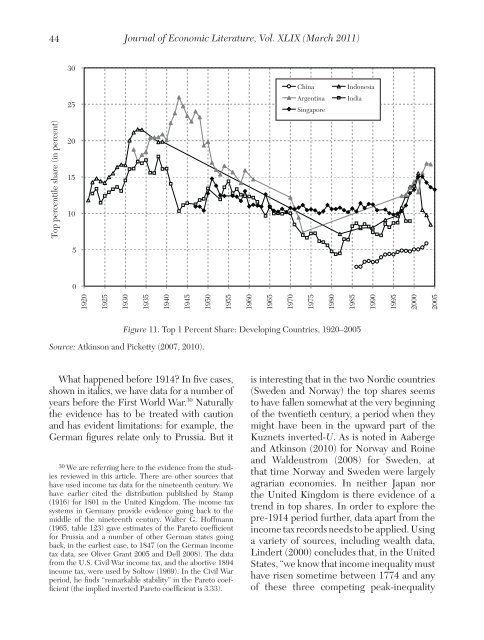"Top Incomes in the Long Run of History" with Tony Atkinson and
"Top Incomes in the Long Run of History" with Tony Atkinson and
"Top Incomes in the Long Run of History" with Tony Atkinson and
You also want an ePaper? Increase the reach of your titles
YUMPU automatically turns print PDFs into web optimized ePapers that Google loves.
44Journal <strong>of</strong> Economic Literature, Vol. XLIX (March 2011)3025Ch<strong>in</strong>aArgent<strong>in</strong>aS<strong>in</strong>gaporeIndonesiaIndia<strong>Top</strong> percentile share (<strong>in</strong> percent)20151050192019251930193519401945195019551960196519701975198019851990199520002005Figure 11. <strong>Top</strong> 1 Percent Share: Develop<strong>in</strong>g Countries, 1920–2005Source: Atk<strong>in</strong>son <strong>and</strong> Picketty (2007, 2010).What happened before 1914? In five cases,shown <strong>in</strong> italics, we have data for a number <strong>of</strong>years before <strong>the</strong> First World War. 30 Naturally<strong>the</strong> evidence has to be treated <strong>with</strong> caution<strong>and</strong> has evident limitations: for example, <strong>the</strong>German figures relate only to Prussia. But it30 We are referr<strong>in</strong>g here to <strong>the</strong> evidence from <strong>the</strong> studiesreviewed <strong>in</strong> this article. There are o<strong>the</strong>r sources thathave used <strong>in</strong>come tax data for <strong>the</strong> n<strong>in</strong>eteenth century. Wehave earlier cited <strong>the</strong> distribution published by Stamp(1916) for 1801 <strong>in</strong> <strong>the</strong> United K<strong>in</strong>gdom. The <strong>in</strong>come taxsystems <strong>in</strong> Germany provide evidence go<strong>in</strong>g back to <strong>the</strong>middle <strong>of</strong> <strong>the</strong> n<strong>in</strong>eteenth century. Walter G. H<strong>of</strong>fmann(1965, table 123) gave estimates <strong>of</strong> <strong>the</strong> Pareto coefficientfor Prussia <strong>and</strong> a number <strong>of</strong> o<strong>the</strong>r German states go<strong>in</strong>gback, <strong>in</strong> <strong>the</strong> earliest case, to 1847 (on <strong>the</strong> German <strong>in</strong>cometax data, see Oliver Grant 2005 <strong>and</strong> Dell 2008). The datafrom <strong>the</strong> U.S. Civil War <strong>in</strong>come tax, <strong>and</strong> <strong>the</strong> abortive 1894<strong>in</strong>come tax, were used by Soltow (1969). In <strong>the</strong> Civil Warperiod, he f<strong>in</strong>ds “remarkable stability” <strong>in</strong> <strong>the</strong> Pareto coefficient(<strong>the</strong> implied <strong>in</strong>verted Pareto coefficient is 3.33).is <strong>in</strong>terest<strong>in</strong>g that <strong>in</strong> <strong>the</strong> two Nordic countries(Sweden <strong>and</strong> Norway) <strong>the</strong> top shares seemsto have fallen somewhat at <strong>the</strong> very beg<strong>in</strong>n<strong>in</strong>g<strong>of</strong> <strong>the</strong> twentieth century, a period when <strong>the</strong>ymight have been <strong>in</strong> <strong>the</strong> upward part <strong>of</strong> <strong>the</strong>Kuznets <strong>in</strong>verted-U. As is noted <strong>in</strong> Aaberge<strong>and</strong> Atk<strong>in</strong>son (2010) for Norway <strong>and</strong> Ro<strong>in</strong>e<strong>and</strong> Waldenstrom (2008) for Sweden, atthat time Norway <strong>and</strong> Sweden were largelyagrarian economies. In nei<strong>the</strong>r Japan nor<strong>the</strong> United K<strong>in</strong>gdom is <strong>the</strong>re evidence <strong>of</strong> atrend <strong>in</strong> top shares. In order to explore <strong>the</strong>pre-1914 period fur<strong>the</strong>r, data apart from <strong>the</strong><strong>in</strong>come tax records needs to be applied. Us<strong>in</strong>ga variety <strong>of</strong> sources, <strong>in</strong>clud<strong>in</strong>g wealth data,L<strong>in</strong>dert (2000) concludes that, <strong>in</strong> <strong>the</strong> UnitedStates, “we know that <strong>in</strong>come <strong>in</strong>equality musthave risen sometime between 1774 <strong>and</strong> any<strong>of</strong> <strong>the</strong>se three compet<strong>in</strong>g peak-<strong>in</strong>equality















